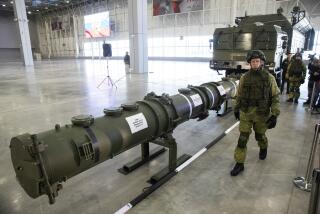Pentagon to remove 50 nuclear missiles from silos
- Share via
WASHINGTON — The Pentagon plans to remove 50 nuclear-armed intercontinental ballistic missiles from their silos over the next four years but not eliminate them from the U.S. arsenal, a move aimed at complying with a 2010 treaty with Russia and avoiding a fight with members of Congress from states where the missiles are based.
Lawmakers had feared reductions in nuclear forces required under the New START treaty would eliminate an entire ICBM squadron at one of three Air Force bases in North Dakota, Montana and Wyoming where the U.S. keeps its 450 Minuteman III missiles — a potentially major economic blow.
But a senior defense official, who briefed reporters Tuesday on the plan, said a total of 50 missiles would be removed from silos at the three missile bases. That will keep all nine ICBM squadrons operational.
The decommissioned missiles will no longer be counted as operational under the treaty, but would continue to be maintained and guarded. The silos also will be kept operational, the official said, describing them as “warm but empty.”
Lawmakers from the three states applauded the plan, which avoids the need to lay off hundreds of Air Force personnel and cut millions of dollars that the bases pump into the local economies.
“Today’s announcement is a big win for our nation’s security and for Malmstrom Air Force Base and north-central Montana,” Sen. Jon Tester (D-Mont.) said in a statement. “Keeping silos on warm status ensures that they remain under the watch of Malmstrom’s security and maintenance personnel.”
Malmstrom, near Great Falls, has been rocked in recent months by the discovery of widespread cheating on proficiency tests by Air Force officers serving on Minuteman III launch teams. Last month, the commander of three squadrons retired and nine other officers were removed after an Air Force investigation found cheating had gone on for two years.
ICBM squadrons also are located at F.E. Warren Air Force Base in Wyoming and Minot Air Force Base in North Dakota.
To comply with treaty limits on warheads and launchers, the Pentagon also will convert 30 B-52 bombers configured for nuclear weapons to carry conventional weapons.
The Navy will disable four launch tubes on each of its 14 missile-carrying submarines. The subs thus will carry up to 56 fewer missiles, each with four nuclear warheads.
The treaty calls for the United States and Russia to each cut their deployed nuclear weapons to 1,550 by 2018, down from a previous ceiling of 2,200. It also set a limit of 700 deployed missiles and bombers.
The decision to largely spare land-based missiles is at odds with the recommendations of some outside experts, who have called for eliminating or deeply cutting the Minuteman III and relying instead on submarines and bombers to carry nuclear weapons.
Bruce Blair, a former ICBM launch officer and founder of Global Zero, a group that seeks elimination of nuclear weapons worldwide, said it would have been more cost effective and “strategically sensible” to eliminate an ICBM squadron.
Because it is in a fixed location, a Minuteman III missile is more vulnerable to a surprise nuclear attack and therefore would have to be fired quickly in a crisis, making it more destabilizing, Blair said.
“It is designed strictly to fight a large-scale nuclear war with Russia,” he said.
More to Read
Sign up for Essential California
The most important California stories and recommendations in your inbox every morning.
You may occasionally receive promotional content from the Los Angeles Times.











